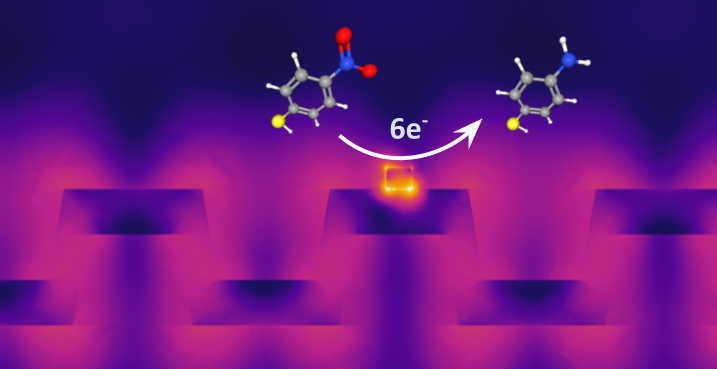Researchers in Prof. Brian Cunningham’s Nanosensors Group at the University of Illinois, in collaboration with Prof. Singamaneni’s research group at Washington University, described a new approach for efficiently catalyzing chemical reactions using light, in the journal ACS Photonics. The researchers harnessed a new approach for amplifying electromagnetic fields in nanometer-scale volumes by coupling the energy from a laser into a nanostructured photonic crystal surface. The electromagnetic fields in the photonic crystal resonate with the laser’s wavelength, and when a metal nanoparticle is placed onto the photonic crystal, the electrons in the metal resonate as well. A portion of the resonating electrons become more reactive than ordinary electrons, and are able to transfer to nearby chemical molecules, and thus catalyze specific chemical reactions. The reactive electrons are often referred to as being “hot,” even though they are not hot in the temperature sense. The research shows that, by coupling laser light to a photonic crystal, chemical reactions are driven forward with greater efficiency, allowing less energy to perform a process than possible without the photonic crystal. Because the approach uses low illumination power that can be distributed over large surface areas, we envision the potential for optically driven chemical reactors. The reactors would be only several micrometers in height, with transparent windows, an inlet for precursors, an outlet for products, and nanoparticle-coated photonic crystals comprising the upper and lower surfaces.
ECE graduate student Qinglan Huang and IGB Fellow Taylor Canady led the research, which was performed in the Holonyak Micro and Nanotechnology Laboratory. The paper, entitled “Enhanced Plasmonic Photocatalysis through Synergistic Plasmonic–Photonic Hybridization“, by Q. Huang, T.D. Canady, G. Gupta, N. Li, S. Singamaneni and B.T. Cunningham, can be found at: ACS Photonics (2020).
Check out the final paper here: FINAL published ACS2020.
